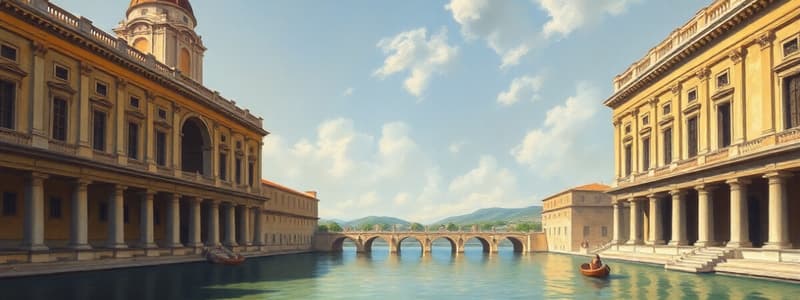Podcast
Questions and Answers
What was the primary purpose of the Cloaca Maxima?
What was the primary purpose of the Cloaca Maxima?
Which structure served as both a temple and a tomb in ancient Rome?
Which structure served as both a temple and a tomb in ancient Rome?
What is the primary function of the identically named rooms in a domus?
What is the primary function of the identically named rooms in a domus?
Which component is primarily found at street level in an insula?
Which component is primarily found at street level in an insula?
Signup and view all the answers
What are the two main parts of a villa according to ancient Roman design?
What are the two main parts of a villa according to ancient Roman design?
Signup and view all the answers
What is the defining feature of the decumanus street in a Roman town?
What is the defining feature of the decumanus street in a Roman town?
Signup and view all the answers
Which room in a domus served as the primary dining area?
Which room in a domus served as the primary dining area?
Signup and view all the answers
What architectural element is associated with the Pantheon’s roof?
What architectural element is associated with the Pantheon’s roof?
Signup and view all the answers
What was the main urban design component during the rise of the Church?
What was the main urban design component during the rise of the Church?
Signup and view all the answers
Which of the following cities became a trading center of the Byzantine Empire?
Which of the following cities became a trading center of the Byzantine Empire?
Signup and view all the answers
Which privilege class alongside nobles contributed to wealth dynamics in towns?
Which privilege class alongside nobles contributed to wealth dynamics in towns?
Signup and view all the answers
What significant decree did Constantine issue regarding Christianity?
What significant decree did Constantine issue regarding Christianity?
Signup and view all the answers
What influence did geographical positioning have on early Christian architecture?
What influence did geographical positioning have on early Christian architecture?
Signup and view all the answers
What trend was observed in urban areas during the period of the Black Death?
What trend was observed in urban areas during the period of the Black Death?
Signup and view all the answers
Which architectural style evolved after the Old Roman traditions were diminished?
Which architectural style evolved after the Old Roman traditions were diminished?
Signup and view all the answers
What factor contributed significantly to the decline of feudal lords during urban development?
What factor contributed significantly to the decline of feudal lords during urban development?
Signup and view all the answers
Which architectural element is most commonly associated with Romanesque architecture?
Which architectural element is most commonly associated with Romanesque architecture?
Signup and view all the answers
What is a defining feature of Santiago de Compostela?
What is a defining feature of Santiago de Compostela?
Signup and view all the answers
What is the main purpose of pilgrimages during the year 1000?
What is the main purpose of pilgrimages during the year 1000?
Signup and view all the answers
What architectural style does Durham Cathedral represent?
What architectural style does Durham Cathedral represent?
Signup and view all the answers
Which of the following is true about the design of Basil's Cathedral?
Which of the following is true about the design of Basil's Cathedral?
Signup and view all the answers
What is a common characteristic of Romanesque cathedrals regarding their windows?
What is a common characteristic of Romanesque cathedrals regarding their windows?
Signup and view all the answers
Which cathedral is noted for having two transepts crossing the nave?
Which cathedral is noted for having two transepts crossing the nave?
Signup and view all the answers
What structural feature distinguishes the Worms Cathedral?
What structural feature distinguishes the Worms Cathedral?
Signup and view all the answers
What is the purpose of the cancelli in a church layout?
What is the purpose of the cancelli in a church layout?
Signup and view all the answers
Which structure is characterized as an octagonal building with fine mosaics for baptism?
Which structure is characterized as an octagonal building with fine mosaics for baptism?
Signup and view all the answers
What is the significance of the term 'major basilica'?
What is the significance of the term 'major basilica'?
Signup and view all the answers
What architectural feature is NOT typically associated with Byzantine architecture?
What architectural feature is NOT typically associated with Byzantine architecture?
Signup and view all the answers
In the floor plan of a church, what is the purpose of the synthronos?
In the floor plan of a church, what is the purpose of the synthronos?
Signup and view all the answers
What is the primary role of the nave within a church?
What is the primary role of the nave within a church?
Signup and view all the answers
Which of the following locations is recognized as a Minor Basilica?
Which of the following locations is recognized as a Minor Basilica?
Signup and view all the answers
Which feature would you typically find in the apse of a church?
Which feature would you typically find in the apse of a church?
Signup and view all the answers
What is the primary function of a dosseret in architectural design?
What is the primary function of a dosseret in architectural design?
Signup and view all the answers
Which of the following statements about St. Mark's Basilica is true?
Which of the following statements about St. Mark's Basilica is true?
Signup and view all the answers
What was the architectural innovation achieved in Hagia Sophia?
What was the architectural innovation achieved in Hagia Sophia?
Signup and view all the answers
Which of the following elements is NOT typically found in a basilica?
Which of the following elements is NOT typically found in a basilica?
Signup and view all the answers
What is the purpose of pendentives in architecture?
What is the purpose of pendentives in architecture?
Signup and view all the answers
What key feature was added to Hagia Sophia after its conversion to a mosque?
What key feature was added to Hagia Sophia after its conversion to a mosque?
Signup and view all the answers
Which architectural term refers to an altar platform commonly found in churches?
Which architectural term refers to an altar platform commonly found in churches?
Signup and view all the answers
Which part of Hagia Sophia is known for its external contact with light through 40 windows?
Which part of Hagia Sophia is known for its external contact with light through 40 windows?
Signup and view all the answers
Study Notes
DRAINAGE AND SEWAGE SYSTEMS
- Cloaca Maxima is among the world's earliest sewage systems, serving as the main storm drainage system of ancient Rome.
PALACE OF DIOCLETIAN
- Located in Split, Croatia, Diocletian's Palace is a fortified complex featuring a slightly irregular rectangle measuring 175 by 216 meters, protected by walls and towers.
- The decumanus serves as the principal east-west street in Roman towns, intersected by the north-south cardo.
PANTHEON
- The Pantheon in Rome is the largest unreinforced concrete dome globally, historically serving as a temple, church, and tomb, located in Campus Martius.
- Main architectural features include the oculus (circular opening) and the soffit (decorated underside of the dome).
DOMUS (PATRCIAN TOWNHOUSE)
- Characterized by party walls, a street-facing entrance, and an enclosed garden area.
- Key components include:
- Vestibulum (entrance)
- Tabernae (shops)
- Cubiculum (bedrooms)
- Impluvium (rainwater collection)
- Oecus (reception room)
- Triclinium (dining room)
- Cucina (kitchen)
INSULA
- Insulae were common tenement blocks for the working class; typically multistory with shops (tabernae) on the ground level.
- Essential features included a central courtyard and light well.
VILLA
- Classical Roman country houses comprising pars urbana (living area) and pars rustica (working area).
SOCIO-HISTORICAL CONTEXT
- The rise of feudalism and the church significantly influenced urban design during these periods.
- Minimal town expansion characterized Constantinople, leading to a proliferation of small coastal port towns and mercantilist cities.
- Cities like Florence, Venice, and Paris became key trading hubs.
EARLY CHRISTIAN ARCHITECTURE (200-1025)
- Influenced by geographical, geological, climate, religious, social, and political changes.
- Constantinian reforms promoted equal rights for Christianity, leading to widespread architectural shifts including basilicas.
- Distinctive elements in early Christian architecture feature an apse, cathedra (bishop's throne), and a well-defined choir.
OLD ST. PETER'S, ROME
- Major structural components include the apse, transept, nave, aisles, narthex, and atrium.
BAPTISTERY
- A designated area within church complexes, typically in an octagonal form and adorned with mosaics.
BASILICA DEFINITION
- Basilicas can be major (papal) or minor, with significant spiritual or historical importance. Notable major basilicas include St. Peter's and St. John Lateran.
BYZANTINE ARCHITECTURE (300-1450)
- Featured circular or polygonal designs with domes on pendentives, rich frescoes, and glass mosaics.
- Characteristics include masonry construction with round arches and shallow domes, often facing west.
HAGIA SOPHIA
- Constructed by Emperor Justinian, this iconic structure merges basilica and dome designs and served as a church, mosque, and now a museum.
- Known for its ornate interiors and innovative architectural solutions, such as pendentives.
ST. BASIL'S CATHEDRAL (MOSCOW)
- Distinguished by bulbous domes, featuring unique architectural designs not replicated throughout Byzantine history.
ROMANESQUE ARCHITECTURE (800-1180)
- Derived from Roman aesthetics, notable for heavy masonry, barrel vaults, and sparse ornamentation.
- The Latin cross plan evolved, and west-facing façades became standard across many structures.
PIAZZA DEL DUOMO, PISA
- A historic complex comprising several religious buildings including a cathedral, baptistery, and bell tower.
NOTABLE CATHEDRALS IN CENTRAL EUROPE
- Worms Cathedral is representative of the Romanesque style with prominent towers.
- Durham Cathedral stands as a significant example of Norman architecture.
- Worcester Cathedral features two transepts, while Canterbury Cathedral showcases a blend of Romanesque and Gothic elements.
Studying That Suits You
Use AI to generate personalized quizzes and flashcards to suit your learning preferences.
Related Documents
Description
Explore the marvels of Roman engineering with this quiz on the Cloaca Maxima drainage system and the architectural significance of Diocletian's Palace in Split, Croatia. Discover how these structures reflect the sophistication of ancient Roman urban planning and infrastructure.




